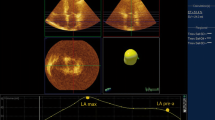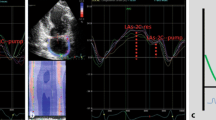Abstract
Background
In end-stage renal disease patients with preserved LV ejection fraction undergoing chronic hemodialysis, we investigated the relationship of left atrial deformational parameters evaluated by two-dimensional speckle tracking imaging (2D-STI) with conventional echocardiographic diastolic dysfunction parameters and brain natriuretic peptide level.
Methods
The study group enrolled 30 patients treated with chronic hemodialysis three times weekly. Two-dimensional transthoracic echocardiography and Doppler studies were performed 44.93 (13.46) immediately before and after HD. All patients had preserved left ventricular ejection fraction.
Results
The mean age of patients was 44.93 ± 13.46 years. The mean brain natriuretic peptide (BNP) value after HD was 221.56 ± 197.79 pg/ml. BNP values were significantly higher before HD (p = 0.004), the anteroposterior diameter, area, and the volumes of the LA decreased significantly after HD. On the other hand, the left atrial ejection fraction (LAEF) and the peak LA strain during LV systole (LAGS) were found to be higher. Before HD, there were significant inverse correlations between LAGS and BNP levels (r = −0.482, p = 0.007), E/E′ (r = −0.33, p = 0.049), LAVmax (r = −0.366, p = 0.047), and LAVmin (r = –0.579, p = 0.001). LAGS had a significant correlation with E′ velocity (r = 0.557, p = 0.001) (Table 5) and LAEF (r = 0.58, p = 0.001). After HD, there were also significant correlations between LAGS and echocardiographic parameters of systolic and diastolic LV function.
Conclusions
We observed that left atrium global peak systolic strain values decreased consistently with deteriorating systolic and diastolic function. Our results suggest that LAGS measurements may be helpful as a complimentary method to evaluate diastolic function.


Similar content being viewed by others
References
McIntyre CW, Odudu A, Eldehni MT, et al. Cardiac assessment in chronic kidney disease. Curr Opin Nephrol Hypertens. 2009;18(6):501–6.
Omae K, Ogawa T, Yoshikawa M, et al. Left atrial dilatation and ST-T changes predict cardiovascular outcome in chronic hemodialysis patients. Heart Vessels. 2012;27(6):610–7.
Morris DA, Gailani M, Vaz Pérez A, et al. Left atrial systolic and diastolic dysfunction in heart failure with normal left ventricular ejection fraction. J Am Soc Echocardiogr Off Publ Am Soc Echocardiogr. 2011;24(6):651–62.
Saraiva RM, Demirkol S, Buakhamsri A, et al. Left atrial strain measured by two-dimensional speckle tracking represents a new tool to evaluate left atrial function. J Am Soc Echocardiogr Off Publ Am Soc Echocardiogr. 2010;23(2):172–80.
Cameli M, Lisi M, Mondillo S, et al. Left atrial longitudinal strain by speckle tracking echocardiography correlates well with left ventricular filling pressures in patients with heart failure. Cardiovasc Ultrasound. 2010;8:14.
Wakami K, Ohte N, Asada K, et al. Correlation between left ventricular end-diastolic pressure and peak left atrial wall strain during left ventricular systole. J Am Soc Echocardiogr Off Publ Am Soc Echocardiogr. 2009;22(7):847–51.
Nishikimi T, Yoshihara F, Morimoto A, et al. Relationship between left ventricular geometry and natriuretic peptide levels in essential hypertension. Hypertension. 1996;28(1):22–30.
Nishikimi T, Futoo Y, Tamano K, et al. Plasma brain natriuretic peptide levels in chronic hemodialysis patients: influence of coronary artery disease. Am J Kidney Dis Off J Natl Kidney Found. 2001;37(6):1201–8.
Daniels LB, Maisel AS, et al. Natriuretic peptides. J Am CollCardiol. 2007;50(25):2357–68.
Mosteller RD, et al. Simplified calculation of body-surface area. N Engl J Med. 1987;317(17):1098.
Shizuku J, Yamashita T, Ohba T, et al. Left atrial volume is an independent predictor of all-cause mortality in chronic hemodialysis patients. Intern Med Tokyo Jpn. 2012;51(12):1479–85.
Leung DY, Boyd A, Ng AA, Chi C, et al. Echocardiographic evaluation of left atrial size and function: current understanding, pathophysiologic correlates, and prognostic implications. Am Heart J. 2008;156(6):1056–64.
Kim SJ, Han SH, Park JT, et al. Left atrial volume is an independent predictor of mortality in CAPD patients. Nephrol Dial Transplant Off PublEur Dial TransplAssoc—EurRen Assoc. 2011;26(11):3732–9.
Losi MA, Memoli B, Contaldi C, et al. Myocardial fibrosis and diastolic dysfunction in patients on chronic haemodialysis. Nephrol Dial Transplant Off PublEur Dial TransplAssoc—EurRen Assoc. 2010;25(6):1950–4.
Boyd AC, Richards DAB, Marwick T, et al. Atrial strain rate is a sensitive measure of alterations in atrial phasic function in healthy ageing. Heart. 2011;97(18):1513–9.
Cho G-Y, Chan J, Leano R, et al. Comparison of two-dimensional speckle and tissue velocity based strain and validation with harmonic phase magnetic resonance imaging. Am J Cardiol. 2006;97(11):1661–6.
Vianna-Pinton R, Moreno CA, Baxter CM, et al. Two-dimensional speckle-tracking echocardiography of the left atrium: feasibility and regional contraction and relaxation differences in normal subjects. J Am Soc Echocardiogr Off Publ Am Soc Echocardiogr. 2009;22(3):299–305.
Ogawa K, Hozumi T, Sugioka K, et al. Automated assessment of left atrial function from time-left atrial volume curves using a novel speckle tracking imaging method. J Am Soc Echocardiogr Off Publ Am Soc Echocardiogr. 2009;22(1):63–9.
Değirmenci H, Bakırcı EM, Demirtaş L, et al. Relationship of left atrial global peak systolic strain with left ventricular diastolic dysfunction and brain natriuretic peptide level in patients presenting with non-ST elevation myocardial infarction. Med SciMonitInt Med J ExpClin Res. 2014;20:2013–9.
Lang RM, Bierig M, Devereux RB, et al. Recommendations for chamber quantification: a report from the American Society of Echocardiography’s Guidelines and Standards Committee and the Chamber Quantification Writing Group, developed in conjunction with the European Association of Echocardiography, a branch of the European Society of Cardiology. J Am Soc Echocardiogr Off Publ Am Soc Echocardiogr. 2005;18(12):1440–63.
Barbier P, Solomon SB, Schiller NB, et al. Left atrial relaxation and left ventricular systolic function determine left atrial reservoir function. Circulation. 1999;100(4):427–36.
Appleton CP, Kovács SJ, et al. The role of left atrial function in diastolic heart failure. Circ Cardiovasc Imaging. 2009;2(1):6–9.
Altekin RE, Yanikoglu A, Karakas MS, et al. Evaluation of left atrial function using two-dimensional speckle tracking echocardiography in end-stage renal disease patients with preserved left ventricular ejection fraction. Kardiol Pol. 2013;71(4):341–51.
Cowie MR, Struthers AD, Wood DA, et al. Value of natriuretic peptides in assessment of patients with possible new heart failure in primary care. Lancet. 1997;350(9088):1349–53.
Davis M, Espiner E, Richards G, et al. Plasma brain natriuretic peptide in assessment of acute dyspnoea. Lancet. 1994;343(8895):440–4.
De Lemos JA, McGuire DK, Drazner MH, et al. B-type natriuretic peptide in cardiovascular disease. Lancet. 2003;362(9380):316–22.
Haug C, Metzele A, Kochs M, et al. Plasma brain natriuretic peptide and atrial natriuretic peptide concentrations correlate with left ventricular end-diastolic pressure. Clin Cardiol. 1993;16(7):553–7.
Jourdain P, Funck F, Bellorini M, et al. Bedside B-type natriuretic peptide and functional capacity in chronic heart failure. Eur J Heart Fail. 2003;5(2):155–60.
Yamamoto K, Burnett JC, Jougasaki M, et al. Superiority of brain natriuretic peptide as a hormonal marker of ventricular systolic and diastolic dysfunction and ventricular hypertrophy. Hypertension. 1996;28(6):988–94.
Troughton RW, Prior DL, Pereira JJ, et al. Plasma B-type natriuretic peptide levels in systolic heart failure: importance of left ventricular diastolic function and right ventricular systolic function. J Am Coll Cardiol. 2004;43(3):416–22.
Niizuma S, Iwanaga Y, Yahata T, et al. Impact of left ventricular end-diastolic wall stress on plasma B-type natriuretic peptide in heart failure with chronic kidney disease and end-stage renal disease. Clin Chem. 2009;55(7):1347–53.
Niizuma S, Iwanaga Y, Yahata T, et al. Plasma B-type natriuretic peptide levels reflect the presence and severity of stable coronary artery disease in chronic haemodialysis patients. Nephrol Dial Transplant Off Publ Eur Dial Transpl Assoc—EurRen Assoc. 2009;24(2):597–603.
Sivalingam M, Suresh M, Farrington K, et al. Comparison of B-type natriuretic peptide and NT proBNP as predictors of survival in patients on high-flux hemodialysis and hemodiafiltration. Hemodial Int Int Symp Home Hemodial. 2011;15(3):359–65.
Author information
Authors and Affiliations
Corresponding author
Ethics declarations
Conflict of interest
Abid L, S Charfeddine, and S Kammoun declare that they have no conflicts of interest.
Human rights statements and informed consent
All procedures followed were in accordance with the ethical standards of the responsible committee on human experimentation (institutional and national) and with the Helsinki Declaration of 1964 and later revisions. Informed consent was obtained from all patients for being included in the study.
Rights and permissions
About this article
Cite this article
Abid, L., Charfeddine, S. & Kammoun, S. Relationship of left atrial global peak systolic strain with left ventricular diastolic dysfunction and brain natriuretic peptide level in end-stage renal disease patients with preserved left ventricular ejection fraction. J Echocardiogr 14, 71–78 (2016). https://doi.org/10.1007/s12574-016-0276-6
Received:
Revised:
Accepted:
Published:
Issue Date:
DOI: https://doi.org/10.1007/s12574-016-0276-6




